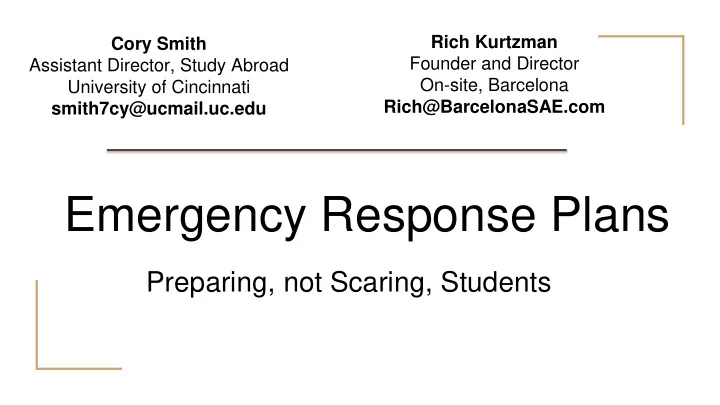

Rich Kurtzman Cory Smith Founder and Director Assistant Director, Study Abroad On-site, Barcelona University of Cincinnati Rich@BarcelonaSAE.com smith7cy@ucmail.uc.edu Emergency Response Plans Preparing, not Scaring, Students
US Study Abroad Students in Numbers
Some Incidents in Europe summer, 2016 Barcelona, Spain July 2016 Student bus crash TOTAL DEATHS: Approximately 800 Southern Italy July 2016 Train collision Ansbach, Germany July 2016 Bombing TOTAL DEATHS in Spanish Road Wuerzberg, Germany July 2016 Axe murders on train accidents in 2016: 1160 Nice, France August 2016 Van crashes into crowd Istanbul, Turkey August 2016 Coup TOTAL DEATHS or Amatrice, Italy August 2016 Earthquake serious injuries on London roads in Budapest, Hungary Sept 2016 Bombing 2015: 2092 Malmö, Sweden Sept 2016 Shootout
What criteria are we using to create our emergency response plans?
Agenda for the session Part I Rubric and Parameters: Case study Part II Communication to stakeholders Part III Technology Part IV A Comparative Perspective: Case study Part IV Conclusion and Q&A
Get to know the audience How many of you are: Working at a university in the US in the Ed Abroad office? Working with students “on-site?” Working with a provider in the US? Faculty who lead programs overseas?
Rubric and Parameters
Case Study in small groups Group 1: You work in the Education Abroad office in the US and you have 20 students on a program in Nice, France. Group 2: You work in the Education Abroad office in the US and you have 20 students on a program in Barcelona, Spain (Barcelona is about 400 miles away from Nice) On a Thursday night (local, French time) a van crashes into a large crowd of people watching the Bastille Day parade in Nice, France and you get the alert on your phone
Questions to discuss 1. What are the next questions you need answered? 2. What do you expect from your on-site partners? 3. Who do you reach out to first? How do you reach out to them? 4. It’s 2 hours later, and there have been 30 confirmed deaths; now what do you do? 5. Terrorism has been ruled out; how, if at all, does that change your strategy? 1. Study abroad office in the US 2. On-site Director in Europe 3. Parent of the student abroad Roles 4. Student abroad 5. University Risk Management 6. University Legal Counsel
What Parameters did you come up with? a. Distance from program site b. Number of people injured or killed c. Day of the week d. Statistics and probability - 2% die from terrorism, most from Motor Vehicle accidents e. X amount of phone calls from parents f. X amount of phone calls from your university’s legal counsel g. Type of activity - does it matter when it’s terrorism or not?
Communication to Stakeholders a. Do students get contacted? Do they have to get back to us? How? a. Do universities get contacted? Who is doing the contacting? a. Do parents get contacted?
TERRORISM I f you google “number of people killed in France in 2016” you get all hits about terrorist deaths. If you google “number of people killed in Chicago in 2016” you get “ Murders in Chicago.”
What can we do? EDUCATE! Hear back from students after every incident
So, what can we do? 1. Education a. What expectations were delivered before the incident? i. To students, parents, institutions 2. Preparation a. Know your parameters b. Drills c. Weekend Plans Form
What else can we do? Technology
Pros and Cons of technology What are your students using? Students are constantly connected, what does that mean for the university or provider response? How does technology strengthen our ERP? Are cell phones mandatory? If so, smartphone? How has technology helped or hindered incidents recently?
Technology that’s out there
Bringing it home A comparative perspective
Case Study in small groups Group 1: You are the head of the international office (responsible both for ISSS and study abroad) at Tulane University, New Orleans . You have 20 international students studying at Tulane. Group 2: You are the head of the international office (responsible both for ISSS and study abroad) at Florida State University, in Tallahassee, FL about 400 miles away. You have 20 international students studying at Florida State University. On a Wednesday night a truck crashes into a large crowd of people watching the Mardi Gras parade and you get the alert on your phone
Questions to discuss 1. What are the next questions you need answered? 2. What do you expect from your on-site partners? 3. Who do you reach out to first? How do you reach out to them? 4. It’s 2 hours later, and there have been 30 confirmed deaths; now what do you do? 5. Terrorism has been ruled out; how, if at all, does that change your strategy? 1. ISSS office in the US 2. International Partners 3. Parent of the student abroad Roles 4. International student abroad in the US 5. University Risk Management 6. University Legal Counsel
Question to discuss Are there different standards for overseas partners than for US universities? If so, why?
Conclusion PLAN & EDUCATE How and why have you chosen to respond to a situation? What constitutes an emergency and successful means of when and how to respond? Create a research driven plan, based on shared best practices from the field implemented in various locations and by various players. Educate the stakeholders: students, parents, administration, faculty, providers, others?
Q & A
Rich Kurtzman Founder and Director On-site, Barcelona Rich@BarcelonaSAE.com Emergency Response Plans Preparing, not Scaring, Students Cory Smith Assistant Director, Study Abroad University of Cincinnati smith7cy@ucmail.uc.edu
Recommend
More recommend